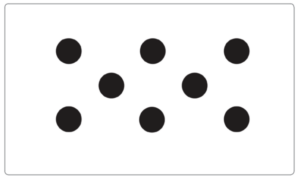



What is a Number Talk? (Excerpts taken from "Number Talks Build Numerical Reasoning" by Sherry Parish, from Teaching Children Mathematics, Oct. 2011)
A successful number talk is rooted in communication. During a number talk, the teacher writes a problem on the board or displays a compelling mathematical image, and gives students time to mentally solve it. Students start with their fists held to their chests and indicate when they are ready with a solution by quietly raising a thumb. Once students have found an answer, they are encouraged to continue finding efficient strategies while others are thinking.
There are five essential components of a classroom number talk.
1. The classroom environment and community: A first step toward establishing a respectful classroom learning community is acceptance of all ideas and answers—regardless of any obvious errors. Rich mathematical discussions cannot occur if this expectation is not in place.
2. Classroom discussions: The benefits of sharing and discussing computation strategies are highlighted below. Students have the opportunity to do the following:
- Clarify thinking.
- Investigate and apply mathematical relationships.
- Build a repertoire of efficient strategies.
- Make decisions about choosing efficient strategies for specific problems.
- Consider and test other strategies to see if they are mathematically logical.
3. The teacher's role: Because a primary goal of number talks is to help students make sense of mathematics by building on mathematical relationships, our role must shift from being the sole authority in imparting information and confirming correct answers to assuming the interrelated roles of facilitator, questioner, listener, and learner. Since the heart of number talks is classroom conversations focused on making sense of mathematics, it is appropriate for the teacher to move into the role of facilitator. Keeping the discussion focused on the important mathematics and helping students learn to structure their comments and wonderings during a number talk is essential to ensuring that the conversation flows in a natural, meaningful manner. As a facilitator, you must guide students to ponder and discuss examples that build on your purposes.
4. The role of mental math: Mental computation is a key component of number talks because it encourages students to build on number relationships to solve problems instead of relying on memorized procedures. One purpose of a number talk is for students to focus on number relationships and use these relationships to develop efficient, flexible strategies with accuracy. When students approach problems without paper and pencil, they are encouraged to rely on what they know and understand about the numbers and how they are interrelated. Mental computation encourages them to be efficient with the numbers to avoid holding numerous quantities in their heads. Mental computation also helps strengthen students’ understanding of place value. By looking at numbers as whole quantities instead of discrete columns of digits, students must use their knowledge and understanding of place value.
5. Purposeful computation problems: Crafting problems that guide students to focus on mathematical relationships is an essential part of number talks that is used to build mathematical understanding and knowledge. The teacher’s goals and purposes for the number talk should determine the numbers and operations that are chosen. Carefully planning before the number talk is necessary to design “just right” problems for students.
